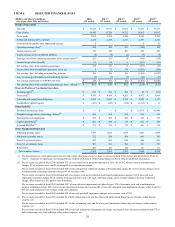Albertsons 2016 Annual Report Download - page 26
Download and view the complete annual report
Please find page 26 of the 2016 Albertsons annual report below. You can navigate through the pages in the report by either clicking on the pages listed below, or by using the keyword search tool below to find specific information within the annual report.24
Impairment charges for long-lived assets or goodwill may adversely affect the Company’s financial condition and
results of operations.
The Company monitors the recoverability of its long-lived assets such as buildings and equipment and evaluates their carrying
value for impairment whenever events or changes in circumstances indicate that the carrying amount of such assets may not be
fully recoverable. Events that may trigger such an evaluation include current period losses combined with a history of losses or
a projection of continuing losses, a significant decrease in the market value of an asset or the Company’s plans for store
closures. When such events or changes in circumstances occur, a recoverability test is performed by comparing projected
undiscounted future cash flows to the carrying value of the group of assets being tested.
The Company annually reviews goodwill to determine if impairment has occurred. Additionally, interim reviews are performed
whenever events or changes in circumstances indicate that impairment may have occurred. If the testing performed indicates
that impairment has occurred, the Company is required to record a non-cash impairment charge for the difference between the
carrying value of the goodwill and the implied fair value of the goodwill in the period the determination is made.
The testing of goodwill for impairment requires the Company to make significant estimates about its weighted average cost of
capital, future revenue, profitability, cash flows, fair value of assets and liabilities, as well as other assumptions. These
estimates may be affected by significant variability, including potential changes in economic, industry or market conditions,
changes in business operations and market strategies, changes in competition or changes in the Company’s stock price and
market capitalization. Changes in these factors, or changes in actual performance compared with estimates of the Company’s
future performance, may affect the fair value of goodwill, which may result in an impairment charge.
The Company cannot accurately predict the amount or timing of any impairment of assets. Should the value of long-lived assets
or goodwill become impaired, the Company’s financial condition and results of operations may be adversely affected.
The Company’s stock price is subject to market and other conditions and may be volatile.
The market price of the Company’s common stock may fluctuate significantly in response to a number of factors. These factors,
some of which may be beyond the Company’s control, include the perceived prospects and actual operating results of the
Company’s business; changes in estimates of the Company’s operating results by analysts, investors or the Company; trading
activity by our large stockholders; the Company’s actual operating results relative to such estimates or expectations; actions or
announcements by the Company or its competitors; litigation and judicial decisions; legislative or regulatory actions; and
changes in general economic or market conditions. In addition, the stock market in general has from time to time experienced
extreme price and volume fluctuations. These market fluctuations could reduce the market price of the Company’s common
stock for reasons unrelated to the Company’s operating performance.
ITEM 1B. UNRESOLVED STAFF COMMENTS
None.
ITEM 2. PROPERTIES
The Company’s properties are in good condition, well maintained and suitable to carry on its business. Substantially all of the
Company’s owned and ground-leased real estate are subject to mortgages to secure the Company’s bank credit facilities.
Additional information on the Company’s properties can be found in Part I, Item 1 of this Annual Report on Form 10-K.
























